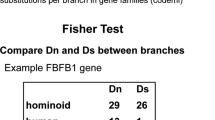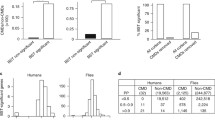Abstract
THE divergence of amino acid sequences which has accompanied evolution of species may be largely due to random fixation of selectively neutral or nearly neutral mutations. This was proposed by Kimura upon consideration of an inferred rapid rate of molecular evolution, the theory of the cost of natural selection, and observed high levels of polymorphism in natural populations1. Among the observations considered to favour the neutral mutation–random fixation theory1–4, the apparent uniformity of the rate of fixation of amino acid substitutions in homologous proteins along several phyletic lines is outstanding. Kimura proposed this test of the neutral mutation theory by examining the amino acid sequences of proteins from so-called ‘living fossils’4. If, for a very long slowly evolving line, a rate of molecular evolution equal to that of more rapidly evolving lines is inferred (and it is assumed that the rate of evolution of physiological adaptations generally parallels the morphological evolutionary rate) then a case is made for the fixation of neutral mutations. The amino acid sequence proposed here5 (Fig. 1) for the α chain of haemoglobin from a ‘living fossil’6, Didelphis marsupialis, the Virginia opossum may be taken for such a test of the neutral mutation theory.
Similar content being viewed by others
References
Kimura, M., Nature, 217, 624–626 (1968).
King, J. L., and Jukes, T. H., Science, 164, 788–798 (1969).
Arnheim, N., and Taylor, C. E., Nature, 223, 900–903 (1969).
Kimura, M., Proc. natn. Acad. Sci. U.S.A., 63, 1181–1188 (1969).
Stenzel, P., thesis (Univ. Oregon Medical School, 1974).
Simpson, G. G., The Meaning of Evolution (Yale University Press, 1949).
Waterman, M. R., and Stenzel, P., Biochim. biophys. Acta (in the press).
Clegg, J. B., Naughton, M. A., and Weatherall, D. J., Nature, 207, 945–947 (1965).
Gross, E., in Methods in Enzymology (edit. by Hirs, C. H. W.), 11, 238–254 (Academic Press, New York, 1967).
Dixon, H. B. F., and Perham, R. N., Biochem. J., 109, 312–314 (1968).
Raftery, M. A., and Cole, R. D., Biochem. Biophys. Res. Commun., 10, 467–472 (1962).
Jones, R. T., in Methods of Biochemical Analysis (edit. by Glick, D.), 18, 205–258 (Interscience, New York, 1970).
Konigsberg, W., in Methods in Enzymology (edit. by Hirs, C. H. W.), 11, 461–469 (Academic Press, New York, 1967).
Light, A., in Methods in Enzymology (edit. by Hirs, C. H. W.), 25, 253–261 (Academic Press, New York, 1972).
Brimhall, B., Duerst, M., Hollan, S. R., Stenzel, P., Szelenyi, J., and Jones, R. T., Biochim. biophys. Acta, 336, 344–360 (1974).
Schroeder, W. A., Shelton, J. R., Shelton, J. B., Robberson, B., and Babin, D. R., Arch. Biochem. Biophys., 120, 1–14 (1967).
Matsuda, G., Gehring-Muller, R., and Braunitzer, G., Biochem. Zeit., 338, 669–673 (1963).
Jones, R. T., Brimhall, B., and Duerst, M., Fedn Proc., 30, 1259 (1971).
Braunitzer, G., Flamm, U., Best, J. S., and Schrank, B., Z. Physiol. Chemie, 349, 1073–1075 (1968).
Braunitzer, G., et al., Z. Physiol. Chemie, 325, 283–286 (1961).
Beard, J. M., and Thompson, E. O. P., Aust. J. biol. Sci., 24, 765–786 (1971).
Whittaker, R. G., Fisher, W. K., and Thompson, E. O. P., Aust. J. biol. Sci., 26, 877–888 (1973).
Matsuda, G., Takei, H., Wu, K. C., and Shiozawa, T., Intern. J. Prot. Res., 3, 173–174 (1971).
Hilse, K., and Braunitzer, G., Z. Physiol. Chemie, 349, 433–450 (1968).
Haldane, J. B. S., J. Genet., 55, 511–524 (1957).
Maynard-Smith, J., Nature, 219, 1114–1116 (1968).
Crow, J. F., in Biomathematics (edit. by Kojima, K.), 1, 128–177 (Springer-Verlag, Heidelberg, 1970).
Author information
Authors and Affiliations
Rights and permissions
About this article
Cite this article
STENZEL, P. Opossum Hb chain sequence and neutral mutation theory. Nature 252, 62–63 (1974). https://doi.org/10.1038/252062a0
Received:
Revised:
Issue Date:
DOI: https://doi.org/10.1038/252062a0
- Springer Nature Limited
This article is cited by
-
Molecular evolutionary clock and the neutral theory
Journal of Molecular Evolution (1987)
-
On the molecular evolutionary clock
Journal of Molecular Evolution (1987)
-
Evolutionary changes in protein composition — evidence for an optimal strategy
Journal of Molecular Evolution (1979)
-
On the tryptic peptides from hemoglobin chains of six carnivores
Journal of Molecular Evolution (1977)
-
Evolutionary changes ofα-crystallin and the phylogeny of mammalian orders
Journal of Molecular Evolution (1977)





